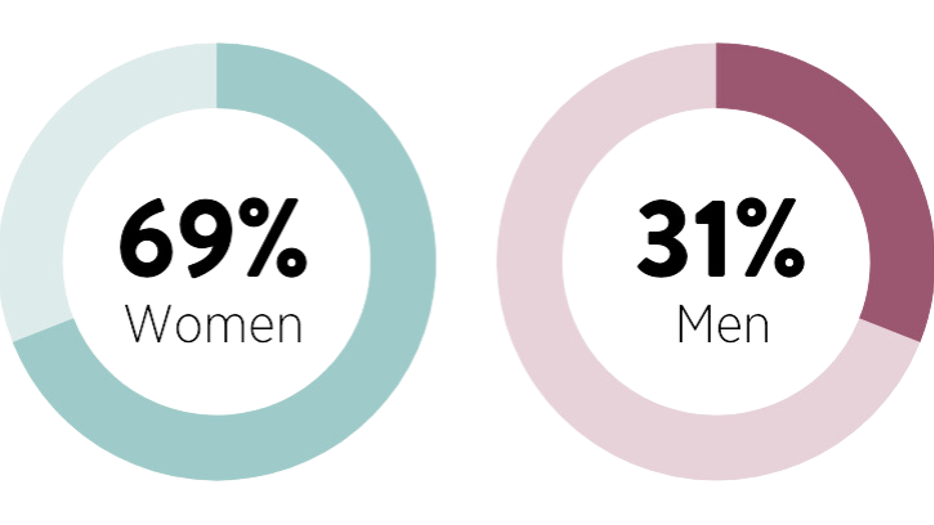Sub-goal 2: Economic equality
Men earn more money than women, and the income gap between genders is increasing. Besides wages, there are many other factors contributing to women not having the same opportunities as men regarding economic independence, including conditions in the labor market, tax and pension systems, sickness rates, and unpaid household and care work.

According to the second gender equality policy objective, women and men should have the same opportunities and conditions regarding paid work that provides lifelong economic independence.
Income disparities between women and men are increasing
Women's average disposable income is significantly lower than men's, more than twenty percent lower. Disposable income is based on earnings from work, benefits, and capital minus taxes. Over a lifetime, the income difference amounts to 6.3 million SEK.
The latest measurements from Statistics Sweden (SCB) show that the disparity in disposable income between women and men is increasing. Over the past two years, the gap has widened more than before. In 2022, men aged 20-64 had an average of 81,500 SEK more in disposable income per year than women in the same age group, representing a difference of 21 percent. For women and men over 65 years old, the gap is closer to 30 percent, amounting to 99,200 SEK. A significant explanation for this trend is that income from capital has increased more in recent years. Since men, on average, own more capital, this has greatly influenced the trend.
Women's lower incomes are also explained by the fact that women are more likely to be outside the labor market and work part-time in low-paying occupations. Women also take more parental leave, study for longer periods, and have higher rates of sickness absence than men.
More difficult for foreign-born women and women with disabilities
Age, education, occupation, country of birth and disability are some factors that, together with gender, affect the possibility of work and thus a gender-equal economy. It takes longer for foreign-born women than foreign-born men to establish themselves on the Swedish labour market, regardless the of level of education.
Women with disabilities have worse conditions on the labor market than men with disabilities, and women and men in the rest of the population. They are more often long-term unemployed, work involuntarily part-time and experience negative attitudes in working life. Women with disabilities are overrepresented in the group living below the relative poverty line.
More businesses are owned by men
When it comes to entrepreneurship, there are many gender disparities. Men are more likely to run businesses than women. Additionally, there are significant differences between women's and men's entrepreneurship in terms of ownership, capital, and types of businesses. In 2021, only 25 percent of owners of private limited companies were women, and 37 percent of sole proprietors were women, according to Statistics Sweden's labor market statistics.
Men also own stocks and properties to a greater extent than women. This results in higher capital income for men, further increasing income disparities. Women have about half as much capital income as men.
Lower wages in occupations dominated by women
The Swedish labor market is clearly gender-segregated. Twenty percent of all women and 17 percent of all men work in occupations with an even gender distribution. The vast majority thus work in occupations dominated by their own gender. To equalise gender segregation, half of all workers would need to change occupations.
Gender segregation has decreased over time, primarily because women have entered previously male-dominated occupations that require higher education. Men are still underrepresented in many female-dominated occupations.
Occupations dominated by women, such as in healthcare and social services, have lower average wages and worse working conditions than male-dominated occupations. Women's average monthly salary amounts to 36,200 SEK and men's to 40,200 SEK. This means that the wage gap between women and men is almost 10 percent and has remained unchanged since 2019.
Part-time and unpaid work
One in five women, but only one in ten men, work part-time. A significant reason for both women and men is that they are not offered full-time work. Other reasons more common for women than men include caring for children, other family reasons, and the physical or psychological demands of the job.
The proportion of women citing childcare as a reason for part-time work has decreased in recent years, while the proportion of part-time working men who care for children or close relatives has almost doubled.

Lower pensions for women
Gender disparities in wages and working conditions are also reflected in lower pensions. According to the Swedish Pensions Agency, women's average pension amounts to 17,000 SEK per month, while men's average pension is 24,200 SEK. This means that the pension gap is 30 percent.
Among newly retired individuals in blue-collar professions, men's pensions before tax are 4,000 SEK higher than those of women in blue-collar jobs. Women who have had white-collar jobs have an average of 10,000 SEK less in pension than men in white-collar jobs. Moreover, 45 percent of women in blue-collar jobs have income pensions that do not reach the level of guaranteed pension.
The tax reforms of the past twenty years have contributed to increased income disparities. For example, the abolition of the high-income tax in 2020 resulted in a larger tax cut for men than for women. Another example is job tax deductions, which contribute to income disparities between women and men.
Harder for foreign-born women and women with disabilities
Age, education, occupation, country of birth, and disability are some factors that, together with gender, influence the ability to find employment. It takes longer for foreign-born women than for foreign-born men to establish themselves in the Swedish labor market, regardless of their level of education.
Women with disabilities have poorer prospects in the labor market than men with disabilities, and women and men in the general population. They are more often long-term unemployed, work involuntarily part-time, and experience negative attitudes in the workplace. Women with disabilities are overrepresented among those living below the relative poverty line.
High food prices hit women harder
During 2022, prices rose sharply, leading to increased inflation. Inflation increased significantly more than both wages and pensions, which has resulted in many facing a tougher economic situation.
Experience from previous economic downturns shows that groups with small economic margins are hit hardest. Studies show that women take on a greater responsibility for household purchases, such as food and clothing for children. As food prices rise, women's finances are hit harder, especially single women with children and elderly women with low pensions, who have the least ability to prioritise their expenses and are hit hard.
What challenges exist for gender equality in the economy?
Women and men should have equal opportunities for economic independence. Women and men should be able to support themselves and any children and be seen as individually responsible for their livelihoods.
The Swedish Gender Equality Agency highlights some important areas to achieve economic equality:
- Counteracting gender-segregated labor markets.
- Increasing the status and wages in female-dominated occupations.
- Improving working conditions and the work environment in female-dominated occupations.
- Actively working against sexual harassment and discrimination in the workplace.
- Taking gender equality perspectives into account when designing initiatives and reforms.
- Analysing reforms that appear gender-neutral but negatively impact gender equality, such as the tax and pension systems.
Publication date: 7 January 2022
Last updated: 13 June 2024
